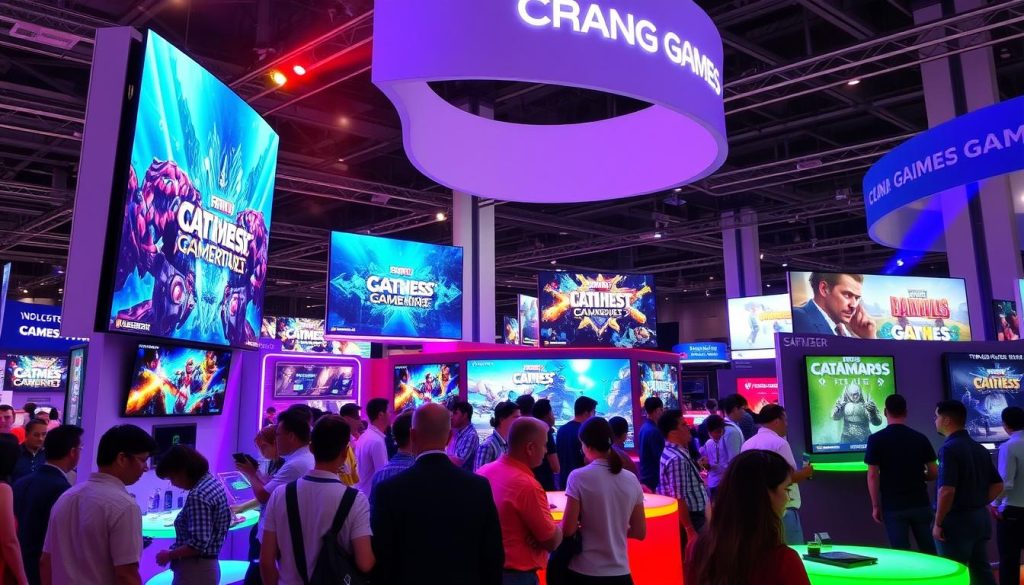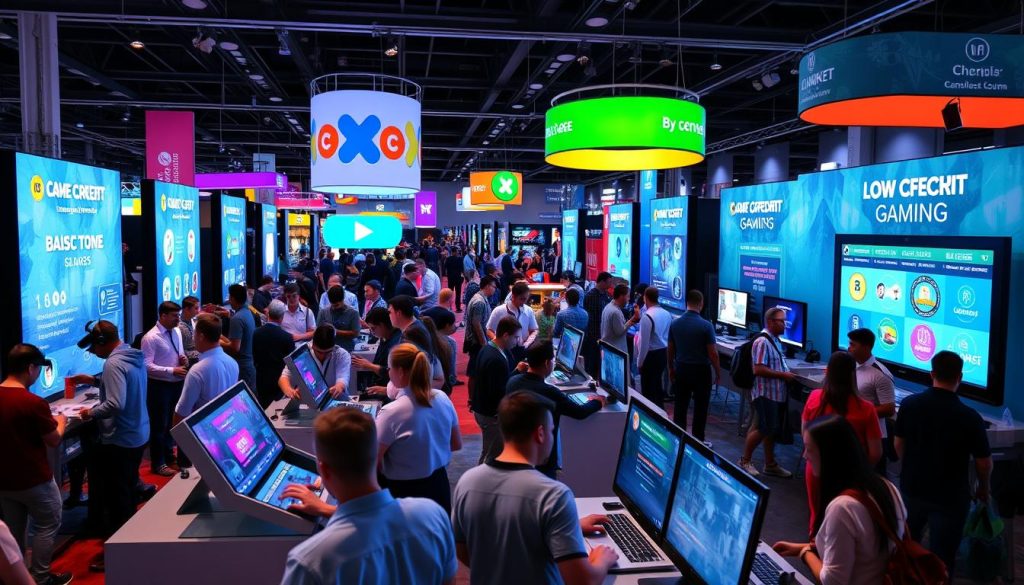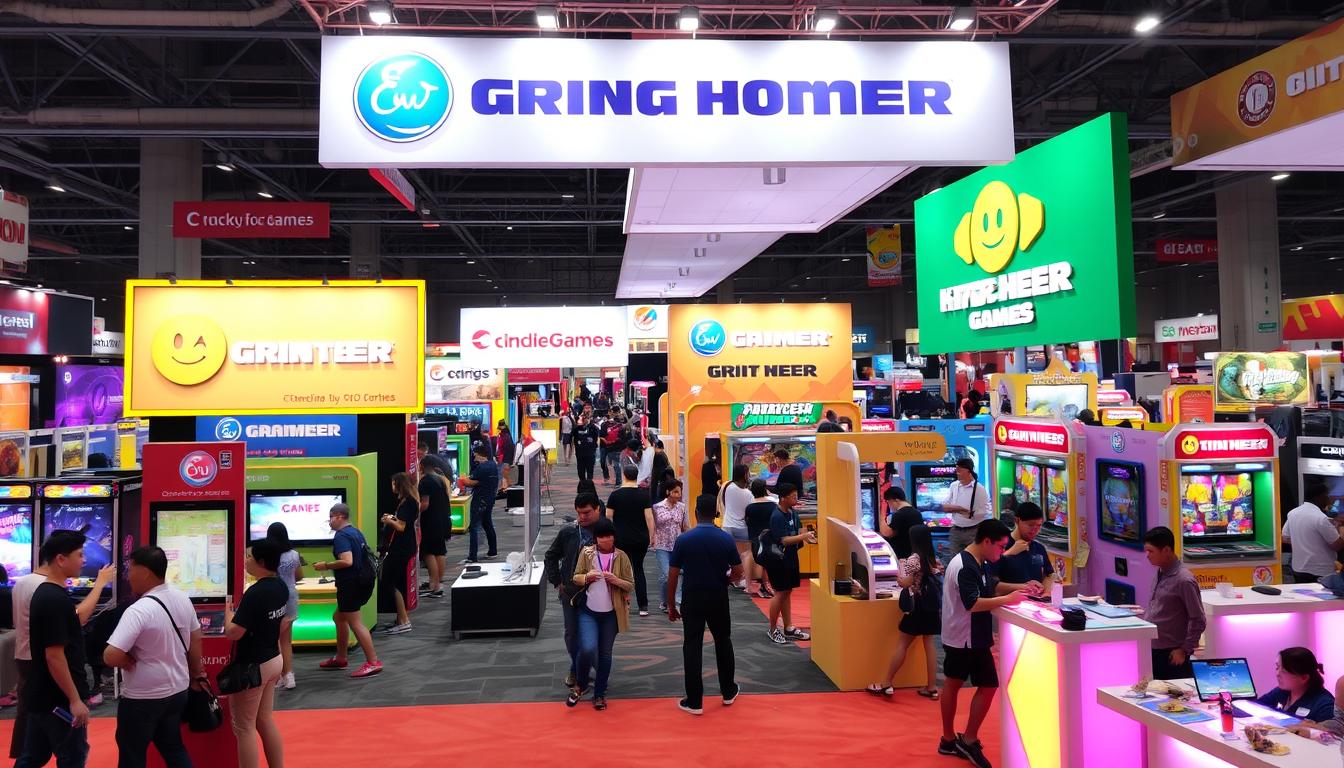Expos are bustling hubs of innovation, but standing out in the crowd can be tough. Enter branded games – the secret weapon for expo success. These interactive experiences are changing the game, quite literally. By blending fun with marketing, companies are creating unforgettable moments that stick with attendees long after the expo ends.
Gamification at expos isn’t just about entertainment. It’s a smart way to grab attention and keep it. Visitors love the chance to play and win, while businesses benefit from increased engagement and valuable data collection. This powerful combo of play and promotion is reshaping how brands connect with their audience at trade shows.
The power of branded games for expo success lies in their ability to turn passive observers into active participants. Through clever game design, companies can showcase their products, values, and unique selling points in a way that’s both enjoyable and memorable. It’s interactive marketing at its finest, offering a fresh approach to making lasting impressions in a sea of exhibitors.
Key Takeaways
- Branded games transform traditional expo experiences
- Interactive marketing increases visitor engagement
- Gamification creates memorable brand interactions
- Games offer unique data collection opportunities
- Branded experiences stand out in crowded expos
- Gamification aligns fun with marketing objectives
Understanding Branded Games: A Game-Changing Expo Strategy
Branded games are revolutionizing trade show engagement, offering a fresh approach to experiential branding. These interactive experiences captivate attendees, creating memorable moments that traditional methods often fail to deliver.
Defining Interactive Marketing at Trade Shows
Interactive marketing at expos goes beyond static displays. It involves creating immersive experiences that actively involve participants. Branded games exemplify this concept, turning passive observers into engaged players. This innovative approach transforms how companies connect with potential clients.
The Psychology Behind Game-Based Engagement
Games tap into our innate desire for competition and achievement. By incorporating brand elements into these experiences, companies create positive associations. This psychological link enhances brand recall and fosters a deeper connection with the audience.
Why Traditional Expo Methods Fall Short
Standard booths and brochures often struggle to capture attention in busy expo environments. Branded games offer a solution, providing:
- Increased dwell time at booths
- Higher levels of brand activation
- More meaningful interactions with attendees
- Improved data collection opportunities
These benefits make branded games a powerful tool for standing out and maximizing trade show ROI.
The Evolution of Experiential Marketing at Expos
Expos have undergone a dramatic transformation in recent years. Gone are the days of static displays and brochures. Today’s successful exhibitors embrace immersive experiences to captivate attendees and boost visitor retention.
The shift towards interactive marketing has revolutionized the expo landscape. Brands now focus on creating memorable moments that engage all senses. This approach taps into the psychology of engagement, making brand messages stick long after the event ends.
Event gamification strategies have emerged as a powerful tool in this evolution. By incorporating game elements into their exhibits, companies create fun, competitive environments that draw crowds and keep them engaged. These strategies can range from simple touchscreen quizzes to elaborate augmented reality experiences.
“Gamification at expos isn’t just about entertainment; it’s about creating meaningful connections between brands and attendees.”
The effectiveness of these new approaches is clear when compared to traditional methods. While old-school booths might struggle to hold attention, gamified experiences often see triple the engagement time. This increased interaction provides more opportunities for lead generation and brand messaging.
| Metric | Traditional Booth | Gamified Experience |
|---|---|---|
| Average Visit Duration | 2-3 minutes | 7-10 minutes |
| Lead Capture Rate | 15-20% | 40-50% |
| Brand Recall | 30% | 70% |
As technology advances, we can expect even more innovative approaches to experiential marketing at expos. Virtual and augmented reality, AI-powered interactions, and personalized experiences are just the beginning of this exciting evolution.
Engage and Capture: The Power of Branded Games for Expo Success
Branded games are revolutionizing the expo landscape, offering a powerful tool for interactive marketing and experiential branding. By leveraging gamification, companies can create unforgettable experiences that resonate with attendees long after the event ends.
Creating Memorable Brand Experiences
Expo visitors crave engaging interactions. Branded games deliver just that, combining fun with brand messaging. These games can range from simple touchscreen quizzes to immersive virtual reality experiences. The key is to align the game’s theme with your brand values, ensuring a cohesive and impactful presentation.
Measuring Engagement Metrics
The beauty of digital games lies in their ability to track user interactions. Metrics like play time, completion rates, and high scores offer valuable insights into attendee engagement. These data points help refine your marketing strategies and improve future expo performances.
Converting Players into Leads
The ultimate goal of expo participation is lead generation. Branded games excel at this by:
- Capturing player information through game registration
- Offering incentives for sharing contact details
- Creating natural conversation starters for sales teams
By seamlessly integrating lead capture into the gaming experience, you transform casual players into potential customers.
“Games are the new frontier of experiential marketing, offering unparalleled engagement and data-rich insights.”
Embracing branded games at expos isn’t just about fun – it’s a strategic move that combines interactive marketing, gamification, and experiential branding into one powerful package. The result? Increased engagement, better leads, and a memorable brand presence that stands out in the crowded expo hall.
Designing Effective Branded Games for Trade Shows
Creating engaging branded games for trade shows requires careful planning and execution. These games serve as powerful tools for trade show engagement and brand activation, offering immersive experiences that captivate attendees.
Aligning Game Mechanics with Brand Values
When designing a game, it’s crucial to reflect your brand’s core values. This alignment ensures that players connect with your brand on a deeper level. For example, a sustainability-focused company might create a recycling-themed game, reinforcing their eco-friendly message.
Technical Considerations and Platform Selection
Choosing the right platform is key to successful implementation. Consider factors like:
- Hardware requirements
- Internet connectivity
- User interface design
- Data collection capabilities
Opt for platforms that offer flexibility and scalability to accommodate various trade show environments.
User Experience Best Practices
To create truly immersive experiences, focus on these user experience elements:
- Intuitive controls
- Clear objectives
- Immediate feedback
- Progressive difficulty
- Rewards system
Remember, the goal is to create a memorable interaction that leaves a lasting impression of your brand.
“Effective branded games transform passive attendees into active brand advocates.”
By following these guidelines, you’ll create branded games that not only attract attention but also drive meaningful engagement at trade shows.
Maximizing ROI Through Interactive Gaming Solutions
Event gamification strategies have revolutionized the expo landscape, offering a powerful tool for visitor retention and brand engagement. By leveraging the power of branded games for expo success, companies can significantly boost their return on investment (ROI).
Interactive gaming solutions create memorable experiences that resonate with attendees long after the event concludes. These engaging activities not only capture attention but also drive meaningful interactions between brands and potential customers.
To maximize ROI, consider these key strategies:
- Design games that align with your brand message
- Incorporate lead capture mechanisms within the game
- Offer valuable prizes to incentivize participation
- Use data analytics to track player engagement and preferences
By implementing these tactics, you’ll transform casual visitors into qualified leads. The power of branded games for expo lies in their ability to create lasting connections, much like how beauty businesses cultivate customer loyalty.
“Interactive gaming at expos isn’t just about entertainment; it’s a strategic tool for boosting brand recall and driving conversions.”
Measuring the impact of your gaming solutions is crucial. Track metrics such as participation rates, time spent engaging with your brand, and lead quality to gauge the effectiveness of your event gamification strategies. This data-driven approach ensures you continually refine your tactics for maximum ROI.
Implementation Strategies for Successful Game Integration
Bringing branded games to life at trade shows requires careful planning. Let’s explore key strategies for seamless integration of interactive marketing elements into your expo presence.
Staff Training and Game Management
Equip your team with the skills to manage gamification at trade shows. Train staff on game rules, troubleshooting, and engaging visitors. A well-prepared team enhances trade show engagement and creates a smooth experience for attendees.

Technical Setup and Troubleshooting
Ensure a robust technical foundation for your branded games. Test all equipment before the event, have backup devices ready, and create a troubleshooting guide. This preparation minimizes downtime and keeps your interactive marketing efforts running smoothly.
Data Collection and Privacy Compliance
Implement secure data collection methods that comply with privacy regulations. Clearly communicate how you’ll use visitor information gathered through gamification. This transparency builds trust and enhances customer relationships while maximizing the value of your interactive marketing efforts.
- Use consent forms for data collection
- Encrypt sensitive information
- Provide opt-out options for participants
By focusing on these implementation strategies, you’ll create a powerful gamification experience that drives trade show engagement and delivers measurable results for your brand.
Case Studies: Successful Branded Games at Major Expos
Branded games have revolutionized the expo landscape, creating unforgettable experiences for attendees. Let’s dive into real-world examples of companies that have mastered experiential branding through innovative game designs.
Tech giant IBM wowed CES attendees with their AI-powered quiz game. Players tested their knowledge while IBM showcased its cutting-edge technology. The game attracted over 10,000 participants, generating 5,000 qualified leads.
Coca-Cola’s brand activation at the Olympics featured a virtual reality experience where visitors “competed” in winter sports. This immersive experience garnered media attention and increased social media engagement by 300%.
At SXSW, Adobe created a digital art game that let attendees create masterpieces using their software. The game attracted creative professionals and resulted in a 25% increase in product trial sign-ups.
“Our branded game at SXSW was a game-changer. It allowed us to connect with our target audience in a fun, memorable way,” said Adobe’s Marketing Director.
Here’s a comparison of these successful branded games:
| Brand | Event | Game Type | Results |
|---|---|---|---|
| IBM | CES | AI Quiz | 5,000 leads |
| Coca-Cola | Olympics | VR Sports | 300% social engagement increase |
| Adobe | SXSW | Digital Art Creation | 25% increase in trial sign-ups |
These case studies highlight the power of branded games in creating memorable experiences and driving tangible business results at major expos.
Future Trends in Expo Gaming and Interactive Experiences
The world of expo gaming is evolving rapidly, bringing new ways to boost visitor retention and enhance interactive marketing. As technology advances, event gamification strategies are becoming more sophisticated and immersive.
Emerging Technologies in Exhibition Gaming
Cutting-edge tech is reshaping the expo landscape. Augmented reality (AR) and virtual reality (VR) are leading the charge, creating captivating experiences that blend the physical and digital worlds. These technologies allow attendees to interact with products and services in ways never before possible, greatly enhancing visitor retention.

Virtual and Hybrid Event Integration
The rise of virtual and hybrid events has opened new doors for interactive marketing. Modifying contact engagement scores becomes crucial in these digital spaces, allowing for personalized experiences that keep attendees engaged regardless of their physical location.
Predictive Gaming Analytics
Data-driven insights are powering the next generation of event gamification strategies. By analyzing attendee behavior and preferences, exhibitors can create tailored gaming experiences that resonate with their audience. This approach not only improves visitor retention but also provides valuable data for future marketing efforts.
“The future of expo gaming lies in personalization and real-time adaptation. We’re moving towards experiences that evolve with each interaction, creating a unique journey for every attendee.”
As these trends continue to develop, managing contacts effectively will be key to maximizing the impact of interactive marketing at expos. The fusion of technology and creativity promises to transform trade shows into dynamic, engaging environments that leave lasting impressions on attendees.
Conclusion
Branded games are changing the game at expos, offering a fresh way to connect with attendees. These interactive experiences go beyond simple entertainment, tapping into the psychology of engagement and creating lasting brand impressions. As we’ve seen, the power of branded games for expo success lies in their ability to turn passive visitors into active participants.
Gamification has proven its worth in the expo world, driving higher engagement rates and boosting lead generation. By crafting games that align with brand values and incorporating cutting-edge tech, companies can stand out in crowded exhibition halls. The integration of social media with marketing further amplifies the reach and impact of these interactive experiences.
Looking ahead, experiential branding through games is set to evolve with emerging technologies like VR and AI. As expos adapt to include virtual and hybrid elements, branded games will play a crucial role in bridging physical and digital spaces. By embracing these innovative approaches, businesses can create memorable experiences that resonate with attendees long after the expo ends.
The future of expo marketing is interactive, engaging, and fun. Branded games are not just a trend – they’re becoming an essential tool for companies looking to make a lasting impact in the competitive world of trade shows and exhibitions.
FAQ
What are branded games for expos?
Branded games for expos are interactive marketing tools that use gamification to engage attendees at trade shows and exhibitions. These games are designed to reflect a company’s brand identity while providing an immersive and fun experience for visitors, ultimately enhancing brand awareness and lead generation.
How do branded games improve expo success?
Branded games improve expo success by increasing visitor retention, creating memorable brand experiences, and facilitating more meaningful interactions between brands and attendees. They also provide valuable data on engagement metrics and can effectively convert players into qualified leads.
What makes branded games more effective than traditional expo methods?
Branded games are more effective because they leverage interactive marketing and experiential branding to create a more engaging and memorable experience. Unlike static displays or brochures, games actively involve attendees, tapping into the psychology of play to forge stronger connections with the brand.
How can I measure the success of a branded game at an expo?
Success can be measured through various metrics, including the number of game participants, time spent at your booth, lead quality and quantity, social media mentions, and post-event surveys. Many branded games also offer built-in analytics to track user engagement and performance.
What types of branded games work best for expos?
The most effective branded games for expos are those that align with your brand activation goals and audience preferences. Popular options include trivia games, virtual reality experiences, mobile app-based challenges, and interactive touchscreen games. The key is to choose a game that resonates with your brand values and target audience.
How do I design an effective branded game for a trade show?
To design an effective branded game, focus on aligning game mechanics with your brand values, consider technical aspects like platform selection, and prioritize user experience. Ensure the game is easy to understand, quick to play, and provides a clear brand message. Collaborate with experienced game designers or agencies specializing in event gamification strategies.
Can branded games work for virtual or hybrid expos?
Absolutely! Branded games are highly adaptable to virtual and hybrid expo environments. They can be designed as web-based applications, mobile games, or even integrated into virtual event platforms. This flexibility allows for immersive experiences regardless of the event format, ensuring continued engagement with your audience.
What emerging technologies are shaping the future of expo gaming?
Emerging technologies in expo gaming include augmented reality (AR), virtual reality (VR), artificial intelligence (AI), and blockchain. These technologies are enhancing immersive experiences, enabling more sophisticated event gamification strategies, and providing deeper insights through predictive gaming analytics.
How do I ensure my branded game complies with data protection regulations?
To ensure compliance, clearly communicate your data collection practices to users, obtain explicit consent for data gathering, and implement robust data security measures. Work with legal experts to ensure your game adheres to relevant regulations like GDPR or CCPA, depending on your operating regions.
What’s the ROI of implementing branded games at expos?
The ROI of branded games can be substantial, manifesting in increased visitor retention, higher quality leads, enhanced brand recall, and improved customer relationships. While the initial investment may be higher than traditional methods, the long-term benefits in terms of engagement, data collection, and brand loyalty often justify the cost.


